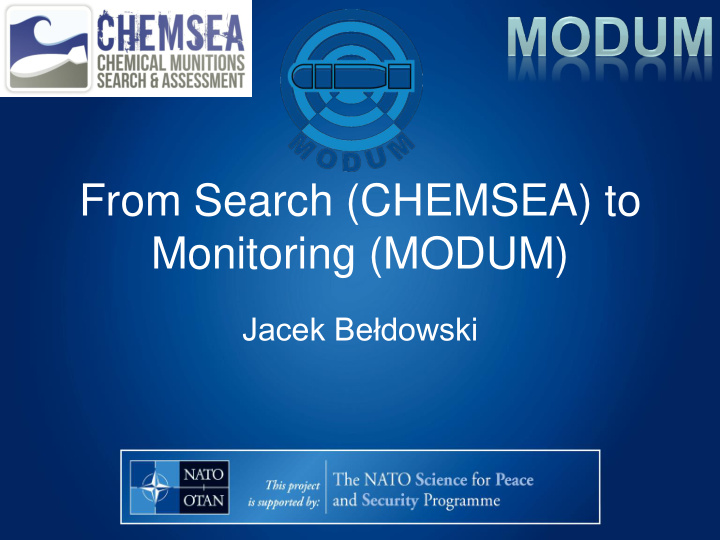



From Search (CHEMSEA) to Monitoring (MODUM) Jacek Bełdowski
In its house beneath the waves, ancient evil lies sleeping [HP.Lovecraft]
�
Legend: CWA Dumps Dredge sites Offshore wind farms (planned) Bottom Trawling intensity Pipelines and Cables
A need to clean up chemical weapons • Priority Area in EU research • Baltic Sea Region Program • UMBRELLA Cluster project Underwater Munitions Baltic REmediation cluster LeAgue
HELCOM IMO Environmental Maritime Fishermen Baltic Sea NGOs Ministries Authorities Strategy WP2 Communication WP 6 Guidelines WP1 Coordination WP3 WP4 WP5 Analysis Detection Eco-Risk
Gotland Dumpsite WP4 Detection Area C: 1756 km 2 RSwN 4th NWF MWDC
Gdańsk Deep
Target chemicals WP3 Analysis Mustard Gas Triphenylarsin e (TPA) Thiodiglycol 1,4-Dithiane (TDG) (DT) Triphenylarsíne oxide (TPAO)
To change to to "View" and click "Header and
Degradation Products
Fish disease index:
Bottom currents
Adding the tracers: Example of the Gdansk deep Bottom currents during 48hours Modeled tracer concentrations after 20 days T o edit click ”View”/ Header and footer”
• Contingency Plans • Policy Paper • Center of Excellence WP6 • Operational models • Guidelines fo contaminanted sediments management • CHEMSEA Handbook • Centre of Excellence
Monitoring • • Peak of corrosion (60y for Slow corrosion • bombs,120y for projectiles Status Quo • • Mass corrosion, mass release Local pollution in areas nobody • Dead sea, toxic fish cares about • • Time bomb approach No accumulation in Biota
Tests Survey Identification Sampling Monitoring Eco-Risk Analysis Modelling
Timeline Environemntal Schema for full Tests & Monitoring Survey Phase Risk scale Preparations Phase Assessment monitoring Nov Oct 13 Nov15 Jan16 Mar16 14
0 A 58 -100 -200 D 56 C -300 B -400 54 -500 10 12 14 16 18 20
Monitoring Network
Eco-Risk Exposure & Spreading • Habitat data from ID • Fish diseases • Eco risk model
Ecological Risk Assessment - pollution • ROV visits • Sediment sampling • On board screening • Lab analyses
Environmental Risk Assessment Phase Habitats Exposure Toxicity Modelling
Outcome • Capacity building • SOPs and QC Procedures • Suitability studies • New method developement • Monitoring network creation
Thank You for attention
Recommend
More recommend